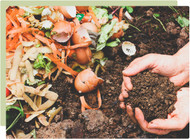Posted by Gubba Team
27th Jul 2020
Home Composting: How easy is it?

In short? Very easy! There's a bit of a myth that to compost effectively at home you need a big space in your yard - or even a yard to start with! - and that it's messy, hard work, needs constant attention and will take forever and forever to work. Well, some of that can be true, but not all of it. In fact, composting methods and techniques have come so far that even homes with little courtyards or nothing more than an apartment balcony can be turning their food waste into valuable compost right now.
Compost - why would we bother?
The issue of food and other organic waste ending up in the landfill is a growing problem. The majority of household waste comes from the kitchen and Kiwis are throwing away truckloads of it each year. Not only does this lead to increasing greenhouse gases from the methane that is produced when food waste decomposes anaerobically (no it's not just burping cows that are to blame!), we're also wasting a magnificent opportunity to return what came from the earth back to the earth in the form of nutrient-rich, highly valuable organic matter.

Compost Bins - all is not equal!
When it comes to choosing the right composting method for your home there are a few things you need to consider as all is not created equal when it comes to what and how you compost your organic waste.
Firstly, consider how serious you are about the whole thing. If you like the idea of it but have never given it a go, then something simple, small and easy like a bokashi bin might be the thing for you. Similarly, if you don't have a lot of space, or a big yard and a lot of garden waste to dispose of, bokashi is brilliant.
If you have a yard, regularly collect lawn clippings, fallen leaves and have a large family producing loads of fruit and veggie scraps, then a large outdoor compost bin might just be the ticket. If budget is not such an issue and speed of composting is important, a tumbler could be the go.
And if you're a dedicated reduce/reuse/recycle warrior then a combination of compost bin, worm farm and bokashi bin may suit you down to the ground. Add to that a few chickens and you’ll be generating enough compost to provide for your neighbor's garden too!
Let’s take a look at the different methods of home composting…
The Good Old-Fashioned Compost Bin
Traditional compost bins are a great place to start if you have space for one in your yard and are looking for a fairly low-maintenance and budget-friendly setup. Compost bins require 3 things to work well - moisture, heat and a good flow of oxygen to break-down the waste effectively. They require aerating and turning of the pile regularly to encourage efficient decomposition.
A DIY compost bin can be fashioned out of recycled timber pallets, you can buy a timber boxed-shaped open bin or you can try a simple, easy to assemble plastic model. Timber ones are great because they are usually cheap, easy to fill allow for good aeration and if big enough can generate quite a good bit of heat inside.
The plastic versions are usually dark coloured to absorb heat from the sun, come with aeration holes to encourage oxygen flow, a lid to keep out critters, and sliding hatch doors for easy access to the decayed material at the bottom. They are generally quite large and can accommodate a lot of waste. You can also buy a handy compost aerator tool to help churn and aerate the contents.
Typically, depending on the temperature (decomposition of waste is quicker in warmer months, and slower in cooler months) and other conditions being ideal, a regular compost bin will produce a lovely compost within 3-6 months. They are generally not mobile - where you set them up is where they will stay until you empty them.
Try a tumbler
You can up the ante a little with a tumbler composter and this speeds up the whole process, plus reduces the amount of effort required to aerate the pile. Tumblers literally do what they say, tumble the compost in an enclosed bin tossing it all around, adding in heaps of oxygen and mixing it thoroughly to break up the waste as it goes. These are also quite large and some even have two compartments so you can keep adding waste in one while the compost material in the other matures. Tumblers can churn-out compost a little quicker than their static cousins simply because of the amount of mixing and aeration they afford to the waste. All conditions being ideal it could be as quick as a couple of months. This is most likely in warmer summer months when the tumbler can generate a good deal of heat. In cooler months, unless they are insulated the tumbler won't retain as much heat and decomposition will be slower.
Bokashi
Bokashi is a convenient and quick method of composting. The word bokashi translates to ‘fermented organic matter’. Instead of allowing food to decay as with traditional composting methods, the bokashi fermentation process pickles food waste - this means you can compost almost any kitchen scraps! Raw or cooked meat, eggs, onions, small bones and cheese can all be swiftly dealt with by a bokashi bin. Plus, the whole process is up to 50% quicker than regular composting, and you won't get any smelly odours as the waste is not decaying. You can find out more about bokashi by reading our blog posts: how bokashi works and how to do it.
Tips for getting the most from your compost bin
As previously mentioned, to decompose effectively a compost bin requires 3 things - air, heat and moisture. Air we’ve covered off - regular turning and mixing adds oxygen into the waste and helps it break down more efficiently. Heat is an interesting one. Heat in compost is mostly generated by the microorganisms that are working hard to breakdown the waste material. In addition to this your outdoor heap gets extra warmth from the sun, and ultimately a good amount of consistent heat is required to destroy any weed seeds, pathogens, the eggs of parasites and fruit flies that might be in your pile. You don’t want it baking hot though, the good-guy microorganisms operate at temperature ranges between 45-70 degrees, any hotter than this they can become less effective. Aeration of the pile will help cool things down a little.
Lastly moisture is also required to boost the ideal conditions for decomposition. The beneficial microorganisms require moisture to survive, and a dry heap will result in the biological activity decreasing and eventually ceasing, and in these little creatures dying. Most kitchen scraps contain enough water to provide all the moisture you need, however if the heap is a little dry, you can add a little water to sort this out. Particularly important when you are adding quite a bit of brown waste - dry leaves, shredded paper, cardboard will impact the moisture levels .
Ready to start composting? Check out our expansive range of compost bins & accessories.


























